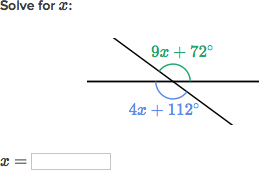If a polygon has n sides, what is the angle sum of the interior angles of the polygon?
B. What is the line segment that goes through the center and stops at either end of a circle called?
B. Diameter

Name a pair of vertical angles and a pair of complementary angles in the diagram above.
Complimentary: Angle INJ and Angle JNK

Find the value of x in the diagram:

Get x = 8

a = 50 degrees
Find the area of the green shaded region (exact area or rounded to the nearest hundredth):

= 144pi - 49pi
= 95pi square meters
= 298.45 square meters
What are the coordinates of the points A and D?

B = (-3, -5)
Find the length of the line segment pictured below as a simplified radical:

*Other answers you may have gotten: sqrt(40) isn't simplified, and 6.32 is a rounded approximation (not a radical).
Find the value of x and y:

x = 50
y = 40
Solution: Note the angle that is vertical to 130 degrees.
Solve 130 = y+90. Get y=40.
Then, note x and y are complementary.
Solve x+40=90. Get x = 50
130 + 90 + 140 + 150 + 90 + x = 720
So x = 120 degrees

= 10pi + 80 mm
(approximately 111.42 mm)
One possibility: (0,0), (0,1), (1,0), (1,1)

You can either use the midpoint formula (harder), or plot the points and estimate your answer based on the choices (easier).
If angle A = 11x + 15 and angle B = 3(x-1), find the exact degree measure of each angle.
Get x = 12
Angle A = 147 degrees
Angle B = 33 degrees

Find the missing angles a, b, c and d.
c = 65 degrees
b = 65 degrees
a = 85 degrees
Find the area of the entire composite region, measured in square units. Give both the exact answer and a rounded answer to the nearest hundredth.
= 100pi + 480 square units
which is approximately 794.16 square units
One possibility: (-1,1), (-2,2), (-3,3)
Find the exact area of the composite figure below (i.e. do not round your answer). Use correct units (assume the x and y axes are measured in inches):



